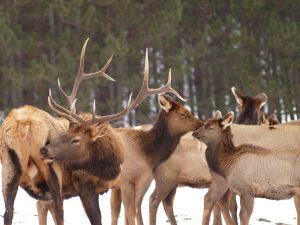A NOCTURNAL FIRST
Serendipity is a descriptor that may well be applied to the first attempted “soft release” in 2000. The lack of snow and relatively mild winter weather provided for a successful unanticipated reintroduction. Serendipity struck, if such is possible, in 2001 as well although the snows, slippery roads and heavy fog experienced in northern Ontario initially gave cause for concern. This second transfer proved to be a grueling 60 hour journey from Elk Island to Ginn Lake, 25 km east of Bancroft for both the 9 drivers and the 49 elk. To boot, they arrived late on January 13, precipitating the need for a nocturnal release, the first such for Ontario’s elk reintroduction program.
With emergency lighting, the volunteers were able to unload the 4 trailers. The first few elk stirred some excitement by breaking to the right towards some of the volunteers who were manning the trailer doors. They had expected the elk to run straight ahead. Some quick thinking then refocused the lighting on volunteers from the elk so the animals could better see their captors and avoid any accidents. As each trailer unloaded its precious cargo, the elk became calmer until the last load simply exited and romped to the join the rest of the herd out of the glow of the lights at the back of the compound on the hemlock ridge. This time there were no elk jumping over the fencing or cows over the moon. This group consisted of 21 pregnant cows, 11 female calves, 13 bulls and 4 bull calves. The female calves would be ready for breeding by next fall. At this point 119 elk had been released at the Ginn Lake site.

On Saturday April 14, fourteen weeks to the day, following Ontario’s first celebrated nocturnal elk release into the compound, the gates were opened and 49 elk from Elk Island National Park were released to their new environment. Co-Chair of the LIC, Barry Wannamaker, said “it took the elk about 3 hours to leave the compound. Something would spook them and they would return to the compound… the ones that sensed freedom bounced around like a bunch of kids, kicking and running.”
Researchers planned to monitor the elk wearing radio collared tracking devices. Ten elk were fitted for GPS technology. These collars contained GPS units that would track and record their positions via satellite. This data would help researchers to make detailed maps showing the areas preferred by elk, population dynamics, food and geographic preferences to name but a few examples. They come with a “buckle” mechanism that is supposed to disengage the collar from the elk about 54 weeks after it is activated for collection by researchers tracking the animals. A video documenting the arrival and dispersal of these elk was to be available to schools and groups for educational purposes. To date 119 elk had been released at the Ginn Lake site with another shipment planned for 2002.
While the elk remained in the compound Bud and Alice Hannah took care of their needs. Each day Bud would take about 45 gallons of water and see to their feed. “They like to come down (from the hemlock shelter at the back of the compound) between 3:00 and 4:00,” he said. During one visit Bud cautioned against any talking. “They know my voice not yours.” In a way, it was like a trip to the dentist’s. Bud talked and I used sign language. From the observation tower we tried to see the elk. We knew they were in the hemlocks but they blended in so well that they were darn hard to see and we knew they were there. By 3:30 they were all feeding. And some of the wild ones from the previous year’s “soft release” would return for feed that Bud placed outside the compound.
“Both Bud and Alice have been a God send for the project and it is nice to have that neighborhood contact on a day to day basis,” said John O’Donnell.

